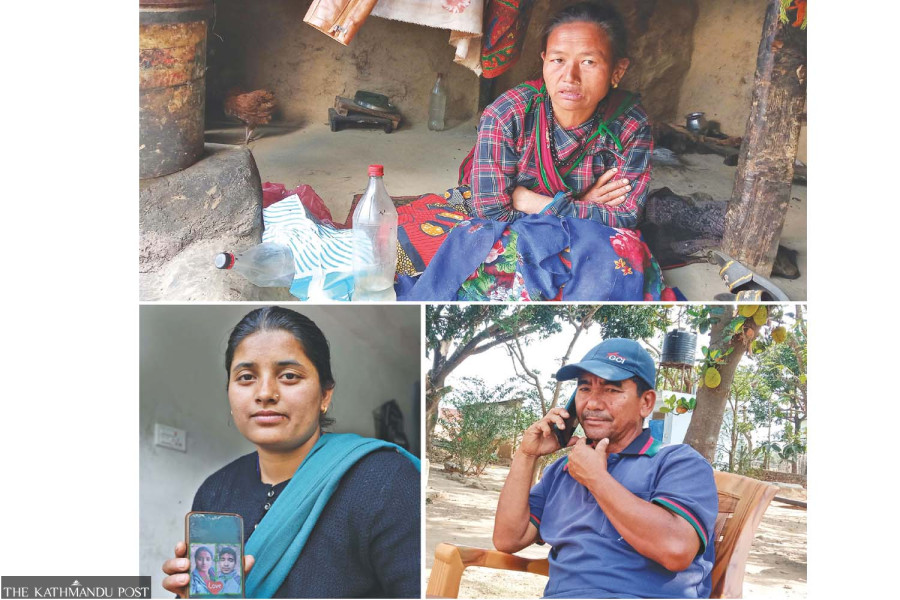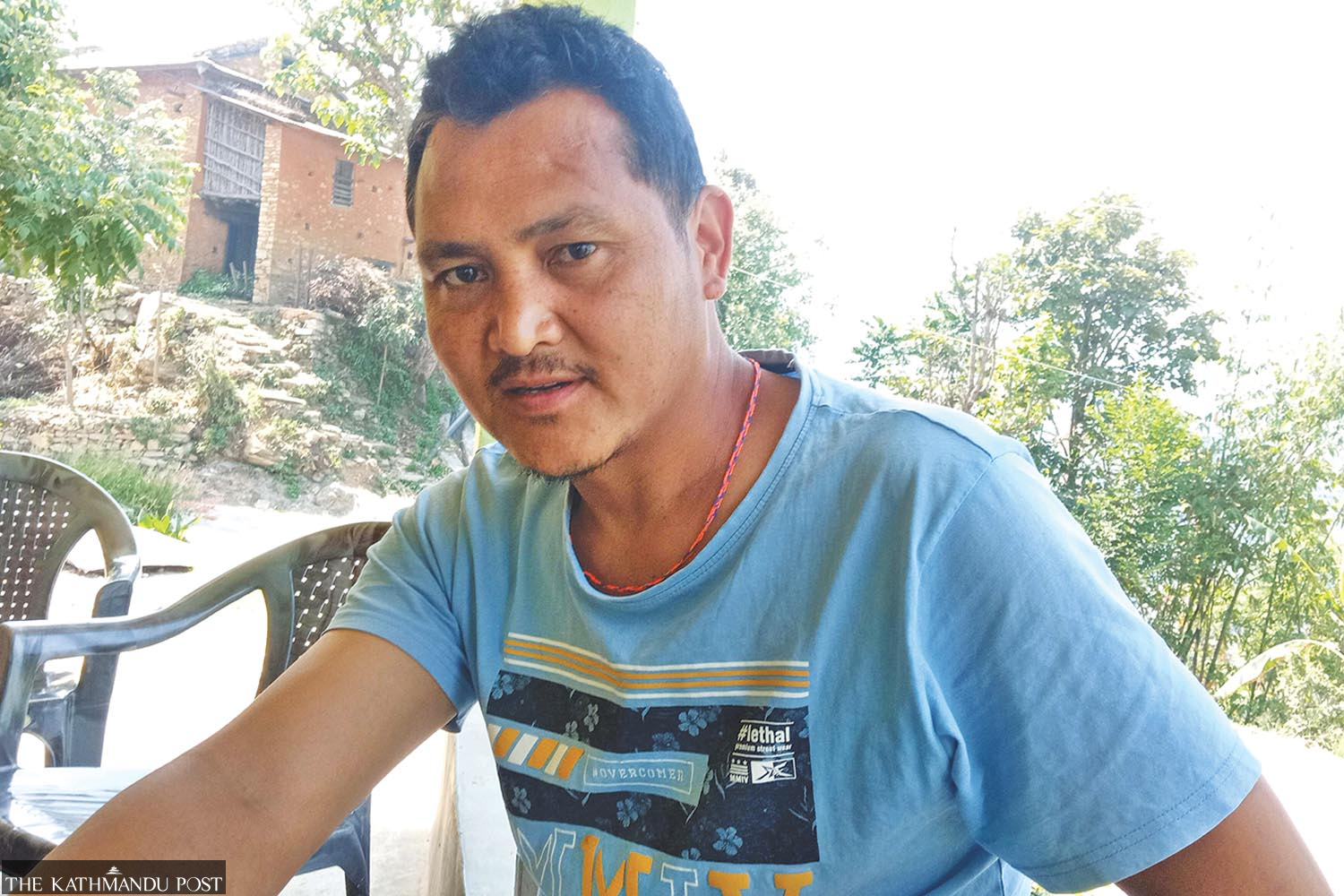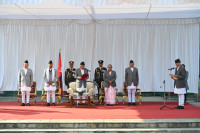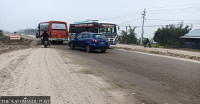National
Desperate youths from Maoist heartland hit US wall
Residents of Maoist strongholds that opposed ‘American imperialism’ paid traffickers huge sums to go to the States.
Janakraj Sapkota
Bharat Budha, chair of Putha Uttarganga Rural Municipality’s ward 10, knows that many youths from his village have made it to the United States via ‘tallo bato’—backdoor route—and that many are still on the way. He also knows that eight of them have been deported from the country and that they have lost a cumulative Rs45 million in the process. The deported youths say that they returned home empty-handed after facing unspeakable ordeals and lost Rs6 million each on average.
The Tak village in Rukum East—a close-knit settlement of 425 houses—was considered the Maoists’ ‘base area’ during the insurgency. Village youths who reached the US through illegal routes and got deported have lost an estimated Rs40 million. The number of those who returned without completing the journey and the amount they lost remain unknown.
To get to the US, the youths have taken loans at up to 36 percent interest per annum from their relatives and village landowners. In Tak village, at least one person each from half of the households has gone abroad, Budha said. “Youths started going to America about six-seven years ago,” he said. “If they could gather enough money, the whole village would try to go to the US.” Budha’s own son had reached the US illegally in 2017, spending Rs3.2 million.
During the insurgency, outsize slogans of revolution would adorn the walls of houses in the village. Hoping for a better life, people from all walks of life helped out the Maoists. But now, village youths are paying the agents to illegally get to the US—a country that the Maoists used to call their ‘enemy’, an ‘imperialistic force’. This has cost the Tak village much and in multiple ways.
Death of a dream
Some of the deported youths have chosen to flee the village altogether, burdened with debt and creditors’ pressure. At least five such families have already left, said a resident. The family of Ram Budha was one of them. On April 28, 2015, Ram, who had returned to Nepal after working in Malaysia for eight years, took the illegal route to the US. He travelled through arduous trails for months and finally arrived in the country. Upon reaching the country, he was detained and had to stay at the detention camp for 27 months. When his refugee application was rejected, he was deported to Nepal in mid-December 2019. He lost Rs4.5 million in the process. He now owes over Rs6 million to creditors. “After the creditors began to put pressure on me, I couldn’t live in the village peacefully,” said Ram, who currently runs a vegetable farm in Tarakeshwar, Kathmandu.
While those who got to the US through illegal routes and fortunately got refugee status there narrate their stories with pride, those who have been deported or returned from half-way have tragic tales to tell.
Nanda Kala Gharti, who lives in a small stone house on the upper flank of Tak village, spends her days in melancholy. Her husband, Dhanlal, had chosen to take the illegal route to the US, and Nanda Kala, a mother of four, is living with the repercussions of his decision. Dhanlal had got into the US after a six-month long arduous journey and was detained immediately. He had to spend four years in the detention camp, before he was deported to Nepal. He had already lost Rs6 million.
Nanda Kala said they now have an insurmountable crisis in their hands. Pointing to her son, she exclaimed, “When will he grow up, go abroad and pay back the loans!”
Dhanlal himself tried to go to Croatia once and spent 15 days in Kathmandu for the process. But after he was turned down, he returned home dejected. “Now we will submit the passport to another agent [for Dhanlal’s trip abroad],” Nanda Kala said. “There’s no point staying here.”
Stories that echo each other
The situation in Sisne Rural Municipality is similar to that of Putha Uttarganga. Here, one can hear plenty of stories of those who have tried to go to the US and those who are fighting refugee cases there. Krishna Regmi, chair of the rural municipality, personally knows seven people who have been deported from the US.
Gangaram Khadka, a resident of Sisne-3, runs a bee and chicken farm. Like other young men in his village, Khadka had headed off to the US via an illegal route on 27 March, 2018. He had reached the US via the New Delhi-Moscow-Barcelona-Bogota-Panama-Costa Rica-Nicaragua-Honduras-Guatemala-Mexico route. When he finally arrived in the US, he was detained and had to spend 11 months in detention. He was deported on 15 March, 2019. He had handed over Rs3.2 millions to the agent and spent Rs2 million to fight the case to become a refugee. “It’s not possible for me to pay back the loan while working in Nepal,” he said. “I aim to pay back some interest and head off abroad again.”
For six months after Khadka was deported, he had anxiety and headache, he said, adding the three people from his village who were deported like him are also struggling with their mental health.
Tikaram Pun, a 40-year-old resident of Bohora village in Musikot-4, is also haunted by his past journey. In September 2017, he reached the US after crossing 17 countries with the help of organised human traffickers. Of the 41 people in his group, 31 were from Rukum East and Rukum West, he said.

Pun, who was detained on arrival in the US, spent 24 months in a detention camp. His refugee application was also refused and so he was deported along with eight other Nepalis. “When I returned, I started having mental health problems. I still suffer from them,” he said. Pun is under pressure from creditors and relatives to pay back the Rs9.2 million loan he had taken for the task.
Those who died on the way
A group of 10 Bangladeshis and seven Nepalis, including Rupak Bohora of Bafikot-3 in Rukum West, were on a mission to reach Costa Rica through Colombia, Caribbean Coast, Capuragana and Panama. But while they were crossing a sea, their boat capsized. As many as 12 died in the incident, including six Nepalis. Rupak’s wife, Geeta, learned about the incident only after six days, on 25 June, 2021.
“I still don’t know what exactly happened,” said Geeta, who had been married off at age 19 and is now a mother of two daughters. The only thing she knows is that Rupak has died and she is now all alone. And that she has Rs5 million in loan taken for Rupak’s trip. She showed a picture of her husband on her phone to this scribe and said, “I only have memories.”
Lack of political will and legal remedies
The concrete bridge over Chewang river is on the edge of Tak village. On the walls of the bridge are paintings of political theorists like Marx, Engels, Lenin, Stalin and Mao, and the iconic slogan, ‘Workers of the world, unite!’, below them. But the slogan appears to be at odds with life in the village. Given the phenomenon of illegal travels to the US through the help of organised human traffickers, the whole village appears to be emptying. Neither the local governments are concerned about the phenomenon nor are the political parties paying attention.
Puniraj Gharti, chair of Putha Uttarganga Rural Municipality, said though the trend is worrying, there’s nothing he can do. “How could we stop them from making the trip when they are struggling to make a living in the village?” he said.
Krishna Regmi, chair of Sisne Rural Municipality, said that the vicious cycle of poverty started after marijuana farming was banned in the country. Then the Maoist insurgency added to the woe, forcing youths to migrate. The signing of the peace agreement in 2006 didn’t herald any change in the economy either and youths are struggling to get jobs. Organised human traffickers are cashing in on this sorry state of affairs, Regmi said. “Meter byajis [usurious lenders] are also promoting this phenomenon,” he added.
The phenomenon is equally rife in Dang’s Tulsipur and Ghorahi. Ramesh Kumar Pandey, chair of Ghorai-15, says that even though many heading to the US are swindled, no complaints are filed at the ward office. “Only those who attempt to go to Saudi Arabia or Qatar file the complaints,” he said.
One can infer from Pandey’s statements that the families of such illegal travellers don’t want to publicise the ordeals of their family members. On the one hand, agents threaten them to not publicise the issue; on the other, they fear they themselves would be punished by law.
According to the Anti-Human Trafficking Bureau, as many as 178 Nepalis, including 174 men, have been deported from the US in the five fiscal years after 2018-19. Of them, the highest 49 are from Rukum while 37 are from Dang. The data doesn’t include those who returned after making it to the half-way or those who have been fighting the legal battle in the US for refugee status. But this data is enough to show that many such youths are from the ‘base areas’ of the Maoist insurgency.
SSP Jeevan Shrestha, chief of the bureau, said that data on the number of such victims and the amounts they have spent is hard to collect since complaints are rarely filed with the police. “This is human trafficking but for a lack of law, we are still compelled to launch the cases as per Human Trafficking and Transportation (Control) Act 2074 BS,” Shrestha said. “The Act provides a maximum penalty of Rs250,000 for the offenders and 50 percent of that as compensation to the victims.” Without specific law, police also invoke the theft and organised crime act to punish the offenders, he added.
On the one hand, police receive no complaints; on the other, the phenomenon sees no control.
Bhaskar Gautam, a political scientist, says the rise in cases of human trafficking in the insurgency’s ‘base areas’ is due to the political system’s abject failure.
While the Maoists raised issues related to livelihood, nationalism and a new kind of democracy to fuel their war machine, after the peace process, it is livelihoods that have been hit the hardest, Gautam said. “The traditional way of life and economy took a hit during the insurgency,” he said. “Developments after the peace process also failed to address that. What sprang up was organised human trafficking.”
(Mahesh KC in Rukum East and Durgalal KC in Dang contributed to this report.)
This report is prepared in collaboration with the Center for Investigative Journalism-Nepal.




 13.12°C Kathmandu
13.12°C Kathmandu















